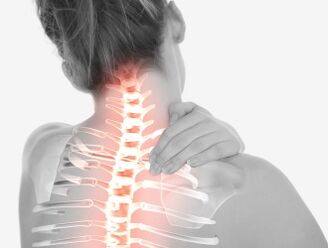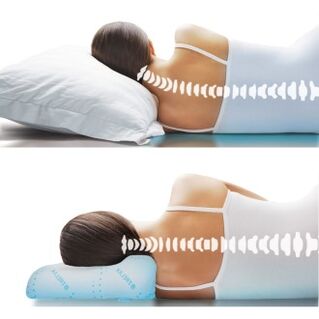
Spinal diseases are unpleasant in themselves, but they pose a great deal of danger if they affect the cervical region.
Despite such harmless pathologiesOsteochondrosis of the cervical area, can trigger the appearance of headaches, difficulty in blood circulation, affected the internal organs.
In the absence of treatment, osteochondrosis can lead to the development of more serious diseases.
To avoid these results, you need to monitor your health carefully and consult your doctor when the first symptom of osteochondrosis appears.
Fortunately, modern medicine has a method that allows the disease to quickly and effectively treat the disease.
What is
Cervical osteochondrosis is a pathology whereSoft intervertebral pulp turns into ossed cloth.In addition, blood vessels and nerve roots are involved in pathogenesis.Osteochondrosis of the cervical area has the ability to disguise themselves for a variety of disorders.
Clinical picture
The distinctive feature of the cervical osteochondrosis is pain in the neck, head, upper back.Patients can complain about dizziness, lack of air, jumping blood pressure, nausea, tongue numbness, loss of consciousness.They often suspect angina pectoris and other diseases of the cardiovascular system.
Classification
Classification of cervical osteochondrosis can be relative to the stage of disease progression:
- 1 degree - degenerative change -dystrophic in intervertebral disc occurs;
- 2 degrees - its own vertebra is subject to change;
- 3 degrees - intervertebral hernia appears.
The prevalence and interest of
Cervical spinal osteochondrosis "becomes younger" literally before our eyes.Examination of different age patients who have a tendency for osteochondrosis indicate that in the current youth problem with the spine arises early (sometimes the first symptoms of the disease arise in adolescence) from representatives of older generations of the family.
People who were born 60-70 years ago clinical relationships about osteochondrosis at mature and old age, although people born 20-40 years ago had osteochondrosis even at a young age.This trend is evidence of significant deterioration in the health of the younger generation due to the decline in nutritional quality and inactive lifestyle.
Clinical manifestations of osteochondrosis are found in about 60 percent of adults living in European countries.It has been noted that women have cervical osteochondrosis at the age of 50-55, and men aged 45-50.
Risk factors
Opportunity to get an increase in osteochondrosis if any:
- spinal development abnormalities;
- Overweight;
- long physical effort;
- bad habits (smoking);
- SEDENTARI LIFE;
- Work, which implies the effect of vibration on the spine (for example, with a vehicle driver);
- long pressure, excessive nervous tension;
- local hypothermia;
- previous injuries to the neck and nape;
- Autoimmune pathology involves cartilage deterioration.
Cause
The main cause of the development of osteochondrosis includes:
- genetic tendency;
- disturbed metabolic processes;
- Poor physical development.
It is difficult to create the true cause of the appearance and development of cervical osteochondrosis, as the disease occurs in young and older people involved in sports and leading an inactive lifestyle.
Psychosomatic
The development of cervical osteochondrosis indicates the inability to survive efficiently.Sometimes people become so strong and confident in their ability that their stability before difficulty turns into rigidity and lack of flexibility.In this case, the attempt to turn their heads is accompanied by stiffness, seizures and other unpleasant sensations.
Also, osteochondrosis can develop in people who are afraid of problems and do not know how to overcome them.In this case, mammalian protective reflexes are triggered, and the head is literally pulled to the shoulder.This provision is considered improper, so after some time, the cervical region muscles begin to hurt and change the shape.
Consequence
Reduce muscle elasticity and flexibility in the joints- Signs - Natural aging of the body.However, in patients with osteochondrosis, they appear earlier than healthy people.Osteochondrosis can cause migraine development, hypertension, respiratory system disease, spinal cord and brain, stroke, etc.
Incorrect osteochondrosis treatment is not less harmfulas a lack of treatment.Inefficient actions from a doctor can cause continuous deterioration in the well -being or defects.
Symptoms and diagnostic methods
The main signs of cervical area osteochondrosis include:
- pain in the back of the head, neck, arms and shoulders, which increases during sneezing, cough and minimum load on the arm;
- burning between shoulder blades, tingling in the legs or arms, numbness;
- pain and crisis in the neck that occur while tilted and turned heads;
- fatigue, weakness;
- fainting and dizziness arising from the sharp turn of the head;
- Headache, which usually starts behind the head, spreads to the temples and crowns.
Other signs of cervical osteochondrosis include noise in the ear, hearing loss, and a decrease in visual acuity.Sometimes the disease is felt by pain in the heart area.
At the first signs of cervical osteochondrosis, you should consult a doctor who will perform a comprehensive examination, will diagnose.In this case, diagnostic methods such as MRI, laboratory studies, ultrasound, ECG can be used.
Treatment
Treatment of cervical osteochondrosis depends on the level of the disease.If in the first stage there is a conservative treatment, wandering, then in the second and third stages of the doctor's job is, first and foremost, to stop the pain syndrome.Improved cases may require surgical treatment intended for compression and vertebral stabilization.
Drug
People with osteochondrosis of the cervical area may be prescribed:
| Band | Information |
| NSAIDs (anti -non -ssteroid drugs) | Helps relieve swelling and pain. |
| Vasodilative medicine | Contributes to increased blood circulation. |
| Sedative, muscle relaxants | They are supplemented to facilitate the general condition of the patient and reduce NSAID doses.Relieves at the same time overstrain nerves and muscle cramps, helping to achieve better therapeutic effects. |
At the end of the therapy course, NSAIDs need to be purchased for the first kit at home, as neck pain can be returned regularly (with stress, overstrain, weather change).Before taking the medicine, consult your doctor.
Surgical
If the positive effects are not observed after conservative treatment of conservative treatment, doctors may recommend the patient's spinal fussia.This procedure allows you to disable the affected vertebra segment.The point is to eliminate the intervertebral disc, the declining of the nerve root, the installation of the implant or the creation of the physiological height of the disc space.
This operation has many side effects and contraindications.Thus, it can cause vertebrogenic defects.That is why surgery is performed in extreme cases.
Exercise, exercise therapy, massage
Massage with cervical osteochondrosis allows you to achieve significant improvement.It is important that the procedure is performed by a professional: absurd movements in the cervical spine area can worsen the situation.Movement should affect the collar zone, the cervical region and the back.

Massage for osteochondrosis implies the replacement of the following actions.
- Favorable.Masseur affects the surface layer of the skin, moving from the head to the top of the back.At the same time, the palm or the fingertips work.
- Squeeze.The inner layer of the skin located at the top of the back is exposed.In this case, the index and thumb across the neck are carried out to take the skin.The fabric next to the vertebra is not involved in this process.
- Trituration.It is carried out to heat the skin, increasing blood flow to the collar area.This procedure must be done very carefully.It is forbidden to affect the spinous vertebra process.Sometimes scrubbing is replaced with a round shot or movement that resembles a saw.
- Knead.It affects the fabric that is very lying, so it has a limited value.It can worsen the pathology.
During the massage, the patient should lie on his stomach, in cases of extreme, sit down.
Also useful for cervical osteochondrosis may be LFK.Normal classes contribute to strengthening the muscle corset, reducing the burden on the cervical spine.You can practice exercise therapy anywhere in the pathology, as well as for prevention.During the severity, the complex is done carefully.
Standard training for the treatment of cervical osteochondrosis is:
- rotation of the head from side to side;
- Leaning back and forward;
- Raising the shoulders with a fixed or relaxing hand with their hold in this position from 15 to 20 seconds;
- Following extensors and neck flexors, when the head is in a regular position.
Each exercise is repeated five to seven times.The lesson continues for 15-20 minutes.The training set should be selected by the LFK specialist, taking into account the level of the disease and condition of the patient.
Home
Home -based osteochondrosis treatment is rarely practiced, for example, in the first stage of the disease.
In this case, the patient is recommended:
- Adjust posture;
- Complete the workplace correctly;
- Do simple physical exercises, including at work.
The positive effects of the musculoskeletal system will have the use of vitamins and minerals, increased motor activity, and swimming.
Prevention

For the prevention of this disease, it is recommended:
- sleep on pillows and orthopedic mattresses;
- Hot bath daily for 10 minutes;
- Visit the bathroom or sauna (relieving neck muscle cramps);
- Avoid sharp tilt and head turn;
- Walking over walking, doing yoga and swimming;
- With "sitting" work, do five -minutes of rest every hour (you need to walk during rest, tilt with body and head in different directions);
- Avoid increasing load on the spine: class heavy, jumping, walking;
- Choose chairs and chairs that support the spine;
- leaving addiction, such as smoking, alcohol abuse;
- Drink at least one and a half liters of water daily.
Eating with cervical osteochondrosis is often recommended (at least five times a day) and in small portions.Priority should be given to steamed or cooked dishes.The salad should be boiled with olive oil.
The forecast of recovery
Predictions for qualified and timely treatment are goodHowever, much depends on the age of the patient, the severity of the manifestation and the level of the disease.It is also important where the person does medical advice on nutrition, lifestyle, and eliminating bad habits.
Conclusion
Thus, in most casesOsteochondrosis of the cervical areaIt is possible to cure.However, keep in mind that the disease can return at any time.To avoid this, it is necessary to observe the precautionary measures and a healthy lifestyle.
In addition, keep in mind:
- The cause of osteochondrosis is difficult to establish.
- The symptoms of the disease are pain in the back of the head and neck.
- Cervical osteochondrosis is treated comprehensively: medicines (especially NSAIDs), massage, exercise therapy.























